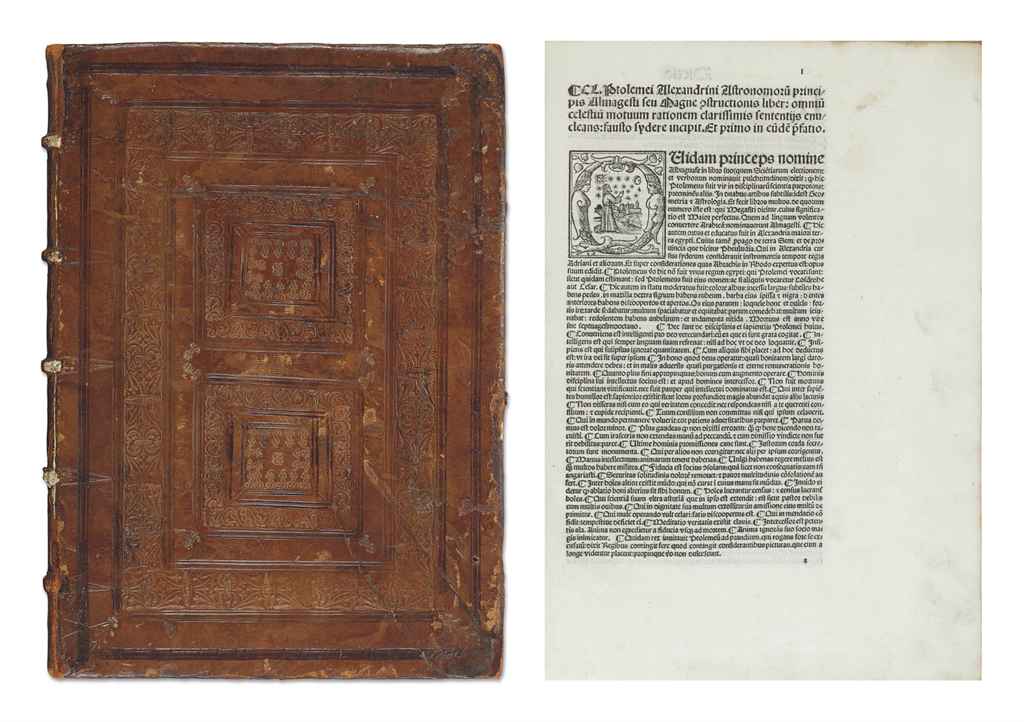PTOLEMAEUS, Claudius (ca 100-ca 170). Almagestum seu magnae constructionis mathematicae opus. Translated from Greek into Latin by Georgius Trapezuntius (1396-1472), edited by Luca Gaurico (1476-1558). Venice: Lucantonio Giunta, 1528.
PTOLEMAEUS, Claudius (ca 100-ca 170). Almagestum seu magnae constructionis mathematicae opus. Translated from Greek into Latin by Georgius Trapezuntius (1396-1472), edited by Luca Gaurico (1476-1558). Venice: Lucantonio Giunta, 1528. 2 o (313 x 218 mm). Collation : A 6 a-s 8 (s8 blank). 149 leaves (of 150, without the terminal blank). Roman, gothic and Greek types. Title-page printed in red and black. Title with printer's woodcut device, ornamental woodcut initials. Woodcut mathematical diagrams in margins. (Some light occasional staining mostly to margins, tiny hole to margin of q8 affecting border of table.) Late 18th-century vellum (hinges repaired). The present edition was the first to publish a Latin translation made from the original Greek text. The Almagest had been translated into Arabic and was known to the later Middle Ages in a Latin translation from the Arabic by Gerard of Cremona; that version was first published in Venice in 1515. Although an extremely literal translation from the Greek had been made in Sicily in the 12th century, this was probably unknown to Pope Nicholas V (1447-55) when he commissioned the present translation from George Trapezuntius. George dedicated both the translation and his own commentary, composed simultaneously, to Nicholas, but he withdrew them both when the commentary was criticized by Bessarion and others. The texts were re-dedicated by Trapezuntius' son to Pope Sixtus IV (1471-84), and the dedication manuscripts survive in the Vatican Library. The Almagest , so called from the medieval Latin form of its Arabic name, was the most important of Ptolemy's astronomical and mathematical works. Known in Greek as the Mathematical Treatise or Collection , it covers every aspect of theoretical mathematical astronomy. "Until the innovative work of Tycho Brahe and Kepler in the late sixteenth and early seventeenth centuries, that is, for nearly fifteen hundred, years, the Almagest was the basis of all sophisticated astronomy, a longevity exceeded only by Euclid's Elements " (N.M. Swerdlow, in Rome Reborn, Washington 1993, p. 144). "Among the instruments mentioned or described in the Almagest are the equatorial armillary for determining the equinoxes at Alexandria; the plinth and the meridional armillary for determinging the mid-day and meridian altitude of the sun; the triquestrum for measuring meridian transits of the moon or fixed stars: and the armillary astrolabon" (Stillwell). Adams P-2214; Norman 1760; See Stillwell 97; Wellcome 5281.
PTOLEMAEUS, Claudius (ca 100-ca 170). Almagestum seu magnae constructionis mathematicae opus. Translated from Greek into Latin by Georgius Trapezuntius (1396-1472), edited by Luca Gaurico (1476-1558). Venice: Lucantonio Giunta, 1528.
PTOLEMAEUS, Claudius (ca 100-ca 170). Almagestum seu magnae constructionis mathematicae opus. Translated from Greek into Latin by Georgius Trapezuntius (1396-1472), edited by Luca Gaurico (1476-1558). Venice: Lucantonio Giunta, 1528. 2 o (313 x 218 mm). Collation : A 6 a-s 8 (s8 blank). 149 leaves (of 150, without the terminal blank). Roman, gothic and Greek types. Title-page printed in red and black. Title with printer's woodcut device, ornamental woodcut initials. Woodcut mathematical diagrams in margins. (Some light occasional staining mostly to margins, tiny hole to margin of q8 affecting border of table.) Late 18th-century vellum (hinges repaired). The present edition was the first to publish a Latin translation made from the original Greek text. The Almagest had been translated into Arabic and was known to the later Middle Ages in a Latin translation from the Arabic by Gerard of Cremona; that version was first published in Venice in 1515. Although an extremely literal translation from the Greek had been made in Sicily in the 12th century, this was probably unknown to Pope Nicholas V (1447-55) when he commissioned the present translation from George Trapezuntius. George dedicated both the translation and his own commentary, composed simultaneously, to Nicholas, but he withdrew them both when the commentary was criticized by Bessarion and others. The texts were re-dedicated by Trapezuntius' son to Pope Sixtus IV (1471-84), and the dedication manuscripts survive in the Vatican Library. The Almagest , so called from the medieval Latin form of its Arabic name, was the most important of Ptolemy's astronomical and mathematical works. Known in Greek as the Mathematical Treatise or Collection , it covers every aspect of theoretical mathematical astronomy. "Until the innovative work of Tycho Brahe and Kepler in the late sixteenth and early seventeenth centuries, that is, for nearly fifteen hundred, years, the Almagest was the basis of all sophisticated astronomy, a longevity exceeded only by Euclid's Elements " (N.M. Swerdlow, in Rome Reborn, Washington 1993, p. 144). "Among the instruments mentioned or described in the Almagest are the equatorial armillary for determining the equinoxes at Alexandria; the plinth and the meridional armillary for determinging the mid-day and meridian altitude of the sun; the triquestrum for measuring meridian transits of the moon or fixed stars: and the armillary astrolabon" (Stillwell). Adams P-2214; Norman 1760; See Stillwell 97; Wellcome 5281.











.jpg?w=400)



Try LotSearch and its premium features for 7 days - without any costs!
Be notified automatically about new items in upcoming auctions.
Create an alert